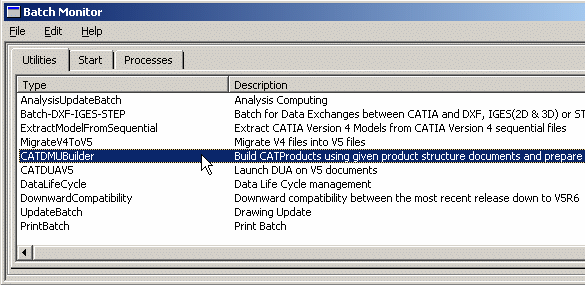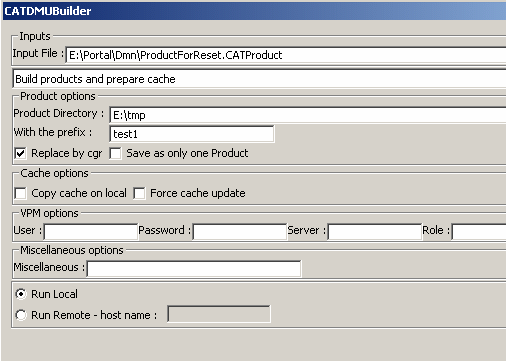 |
The CATDMUBuilder is intended to
save DMU loading time by:
- Feeding the cache with tessellated data corresponding to given
product structures
- Creating CATProducts corresponding to these product structures and
storing them on dedicated local directories
- Using local machine resources when they are not used (night,
week-end)
This capability fills the local cache with all necessary data to avoid
tessellation or access to the PDM cache during interactive loading of given
product structures. This loading will use only the local and release cache.
The extracted CATProducts allow the user to quickly load working or
predefined session without mandatory PDM connection while working in
visualization mode. The loading of these CATProducts will benefit from the
cache feeding.
The product structure file can be any one of the following:
- a product (*.CATProduct)
- a Dynamic PSN (*.psn)
- the identifier of an ENOVIAVPM node (*.CATVpm)
- a Multi-CAD assembly
- a Navigator 4D file
- a Clash file (*.xml) Important: The interferences described in
the xml file must point to a VPM V4 product structure and you must be
connected to VPM V4. Interferences described in the xml file pointing to
product structures in file format or to VPM V5 product structures are not
supported.
DLNames are now supported for the CATDMUBuilder batch process.
|
 |
|
 |
When using input data that
contains references to a PDM system, it is imperative that you be connected
to that PDM system while the CATDMUBuilder process is running. |
 |
- On Windows, it is always necessary
to specify the -env and -direnv options. Note
that, these options should always be specified at the end of the command
line. For more information, see the Infrastructure User's Guide,
Starting a Session on Windows.
- When you build a product using
CATDMUBuilder with a PSN file and the selected instances option, all
documents attached to Parts on the branches of the selected leaves are
taken into account.
|
 |
-
To retrieve the help information, run the command:
CATDMUBuilder -h
-
To feed data to the cache, run the command:
CATDMUBuilder inputlocation
[-user user -spwd cryppwd -role role -server srv] [-product dir]
-
To build the product, run the command:
CATDMUBuilder inputlocation
-product dir -onlyone -nocache
-
To feed the local cache, run the command:
CATDMUBuilder inputlocation -copycache
-
To force re-calculation, run the command:
CATDMUBuilder inputlocation -force
|
|
Windows Examples
CATDMUBuilder -h
CATDMUBuilder c:\u\input.txt
-product c:\proddir
Unix Examples
Invoking the CATDMUBuilder help:
CATDMUBuilder -h
Feeding the cache with tessellated data corresponding to product
structures contained in a directory /u/product
CATDMUBuilder /u/product
Moving CATProducts corresponding to product structures contained in a
distant directory /distant/product, storing them on a local
directory /local/product and feeding the local cache:
CATDMUBuilder /distant/product -product /local/product
Feeding the cache with tessellated data corresponding to product
structures contained in a directory /u/product, which refers to
VPM documents:
CATDMUBuilder /u/product -user XXX -spwd YYY -role VPMDESIGNER
-server ZZZ
|
 |
When using CATDMUBuilder in
conjunction with ENOVIAVPM, it is necessary to first
launch the ENOVIAVPM server:
-
When launched, the CATDMUBuilder will try to execute on
the server side an ENOVIAVPM shell called
StartVPMBatchFromV5Batch.sh . This shell name must not be
changed. This shell must be in the $PATH variable of the ENOVIAVPM
user declared in the mapping (Ex: /V15/vpmadm/code/bin).
-
The StartVPMBatchFromV5Batch.sh shell has to
be created by the ENOVIAVPM administrator and
should look as follows:
!# /bin/ksh
if [ -f $HOME/.profile ] ; then
. $HOME/.profile
fi
. /V15/vpmadm/env/VPMWsUser.sh >/tmp/traces 2>&1
VX0SERV >>/tmp/traces 2>&1
-
The following is an example of a command line used for
treating a CATVpm file:
CATStartV5.sh -batch "CATDMUBuilder /tmp/CATVPM
-db VPMServer -user vpmadm -spwd vpmadm -server server_name
-role VPMADMIN -product /tmp"
where server_name is the name of the server defined in the
ENOVIAVPM interoperability settings (Tools >
Options > Infrastructure > Product Structure > ENOVIAVPM
tab > click Database Administration icon).
|
| |
Arguments -h :
Help.
inputlocation : To define the list of documents to process. It can
be the path of:
- a file containing a list of documents. It must contain one path of
document per line.
- a directory containing documents
Documents of the following types are treated: CATProduct,
CATVpm, psn, xml.
|
|
-product dir
: To extract products and store them in the directory dir.
|
|
-nocache : To run the
batch without generating cache content. Note: This option has no effect
when the product needs to be built from scratch. -copycache : To
copy all cache content from released caches to the local cache.
-force : To force re-calculation of cache content.
-onlyone dircgr : To resolve all links to external
products and save the resulting product locally as one unique product.
|
|
-static : To open a psn
file with static option (valid only for psn). By default it is open with
dynamic option.
-selins : To open a psn file with selected instances (valid only
for psn). By default it is open with all instances.
-replacebycgr dircgr : To replace all components by
related cgr copied in the directory dircgr.
-activate : To activate all shapes and save the activation state.
-deactivate : To deactivate all shapes and save the activation
state.
-prefix prefix : To save all products with a prefix in
their name.
|
| |
-db : Input database type:
For processing data stored in a PDM database.
For details on using the -db option, see
Accessing Data in a PDM Database.
|
| |
-mp : To enable multi-processing for
product building. Multi-process parameters must be set in :
Tools > Options > Digital MockUp >
Multiprocess Settings. -timeout : -timeout
time: set the time out. After this time, child processes will be killed, on
the assumption that they've entered a CPU loop. Available with
multi-process mode (-mp) only. |
| |
- outputformat wrl : To generate a VRML file as output. Note:
In batch mode, as there is no editor, the wrl file will not contain any
viewpoints. |
 |
|
| |
-listcomp : To
list all the components of each product. The directory will contain one
text file per product, the name of which will be the same as the product.
Each file has one component per line.
-noreplace : During the running of the batch process, it could
happen that a file has to be copied in a directory where it already exists.
Without the noreplace option, the file will be overloaded. With the
noreplace option, the file will not be replaced.
-savedata: To save referenced data in the product directory (see
-product above).
|
| |
A user interface is now available
for running the CATDMUBuilder utility.
-
In the menu bar, select Tools > Utility.
The Batch Monitor dialog box appears.

-
Select the CATDMUBuilder batch from the
proposed list.
A dialog box will appear in which you can enter the same information
you would otherwise have entered in a line command:
- Input documents
- Treatment: build products, prepare cache or both
- Product options
- Cache options
- VPM options
- Miscellaneous options (options for dedicated document types)

-
Click the Save button to save all input data
in an XML file for later use
-
Click the Run button to run the batch job
immediately.
-
In the Batch Monitor dialog box, click the
Processes tab to monitor the batch job execution.

For more information on using the Batch Monitor, see the
Infrastructure
User's Guide, Basic Tasks, Running Batches, Running Batches Using the Batch
Monitor. |
|
Diagnostics
Possible exit status values are:
- 0: Successful completion.
- 1: Failure due to any of the following:
- license not available
- cache management deactivated
- missing arguments
- invalid parameter
- missing parameter after an option
- missing input file
- unable to find a file
- unable to open an input file
- bad type of document
- 2 Processing error.
- 3 Partially processed.
|
|
Solutions
- Exit status = 1: Modify the command line using information contained
in the standard error file.
- Exit status = 2: Contact you local support.
- Exit status = 3: Fix the files that cause the problem: their names
are contained in the standard error file. An interactive use of
files may inform about problem.
|

|
CATVpm
The utility can open an ENOVIAVPM assembly
corresponding to all nodes under a given root or a CATProduct stored as
Black-box. This is done using a new type of document CATVpm.
This document is a text file:
- First line: coid
- Second line: compid
- Third line: catenv
- Fourth line: catab (part list or document)
- Other lines: configuration information (one configuration handler per
line)
Example 1: a simple node
3D3D8F8371EA6659
3030303030303030
VPMENV1
PART_LIST
Example 2: a simple node with two config handlers
3D3D8F8371EA6659
3030303030303030
VPMENV1
PART_LIST
CONF1
CONF2
Example 3: a Black box
3D3D976D89064C32
3D3D976D89064C33
VPMENV1
DOCUMENT
|
|

|
![]()